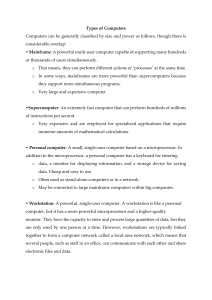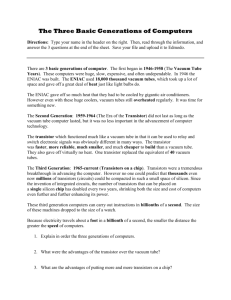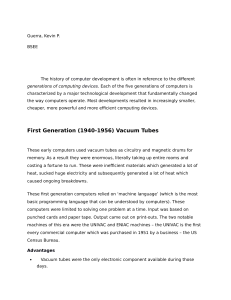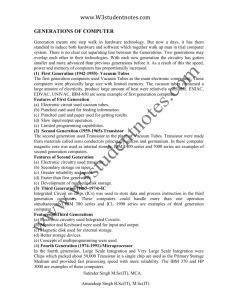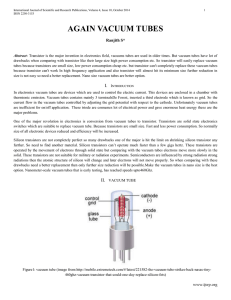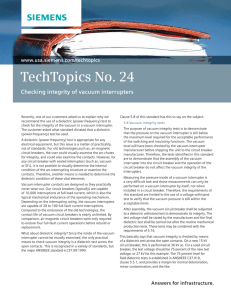5 Generations of Computers Ms. Ceejay Jader 1
advertisement
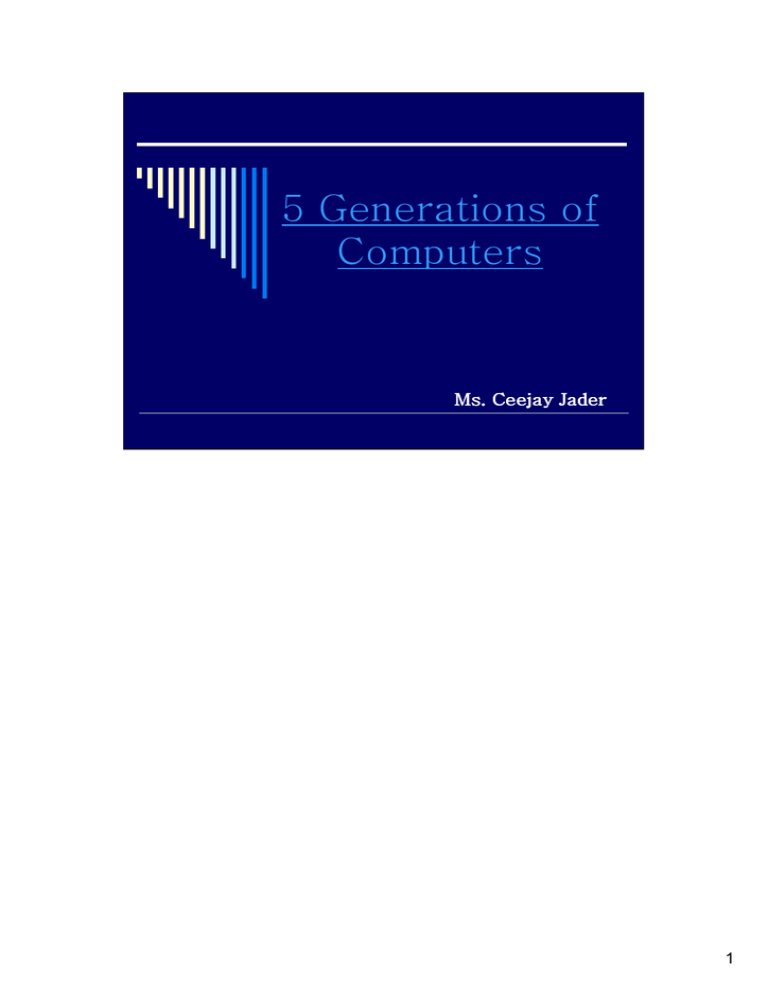
5 Generations of Computers Ms. Ceejay Jader 1 FIRST GENERATION 1940-1956: Vacuum Tubes a glass tube surrounding a vacuum (an area from which all gases have been removed). What makes it interesting is that when electrical contacts are put on the ends, you can get a current to flow though that vacuum. Thomas Edison noticed this first in 1883 2 3 ENIAC First generation computers relied on machine language to perform operations, and they could only solve one problem at a time. Input was based on punched cards and paper tape, and output was displayed on printouts. UNIVAC and ENIAC computers are examples of first-generation computing devices. The UNIVAC was the first commercial computer delivered to a business client, the U.S. Census Bureau in 1951. Electronic Numerical Integrator And Computer 4 Second Generation 1956-1963: Transistors Replaced vacuum tubes and ushered in the second generation of computers. The transistor was invented in 1947 but did not see widespread use in computers until the late 50s. The transistor was far superior to the vacuum tube, allowing computers to become smaller, faster, cheaper, more energy-efficient and more reliable than their first-generation predecessors. Though the transistor still generated a great deal of heat that subjected the computer to damage, it was a vast improvement over the vacuum tube. Second-generation computers still relied on punched cards for input and printouts for output. Second-generation computers moved from cryptic binary machine language to symbolic, or assembly, languages, which allowed programmers to specify instructions in words. High-level programming languages were also being developed at this time, such as early versions of COBOL and FORTRAN. These were also the first computers that stored their instructions in their memory, which moved from a magnetic drum to magnetic core technology. The first computers of this generation were developed for the atomic energy industry 5 Third Generation 1964-1971: Integrated Circuits Transistors were miniaturized and placed on silicon chips, called semiconductors, which drastically increased the speed and efficiency of computers Instead of punched cards and printouts, users interacted with third generation computers through keyboards and monitors and interfaced with an operating system, which allowed the device to run many different applications at one time with a central program that monitored the memory. Computers for the first time became accessible to a mass audience because they were smaller and cheaper than their predecessors 6 7 Fourth Generation 1971-Present: Microprocessors Microprocessor brought the fourth generation of computers, as thousands of integrated circuits were built onto a single silicon chip In 1981 IBM introduced its first computer for the home user, and in 1984 Apple introduced the Macintosh. Microprocessors also moved out of the realm of desktop computers and into many areas of life as more and more everyday products began to use microprocessors. As these small computers became more powerful, they could be linked together to form networks, which eventually led to the development of the Internet. Fourth generation computers also saw the development of GUIs, the mouse and handheld devices. 8 NEW Motherboards 9 Check this website for the different types of CPU/Microprocessor http://www.cpu-world.com/info/die_pictures.html 10 Fifth Generation Present and Beyond: Artificial Intelligence Based on artificial intelligence, are still in development, though there are some applications, such as voice recognition, that are being used today. ifth generation computing devices, based on artificial intelligence, are still in development, though there are some applications, such as voice recognition, that are being used today. The use of parallel processing and superconductors is helping to make artificial intelligence a reality. The goal of fifth-generation computing is to develop devices that respond to natural language input and are capable of learning and self-organization. 11 References www.pbs.org www.computerhistory.org www.computermuseum.il 12

